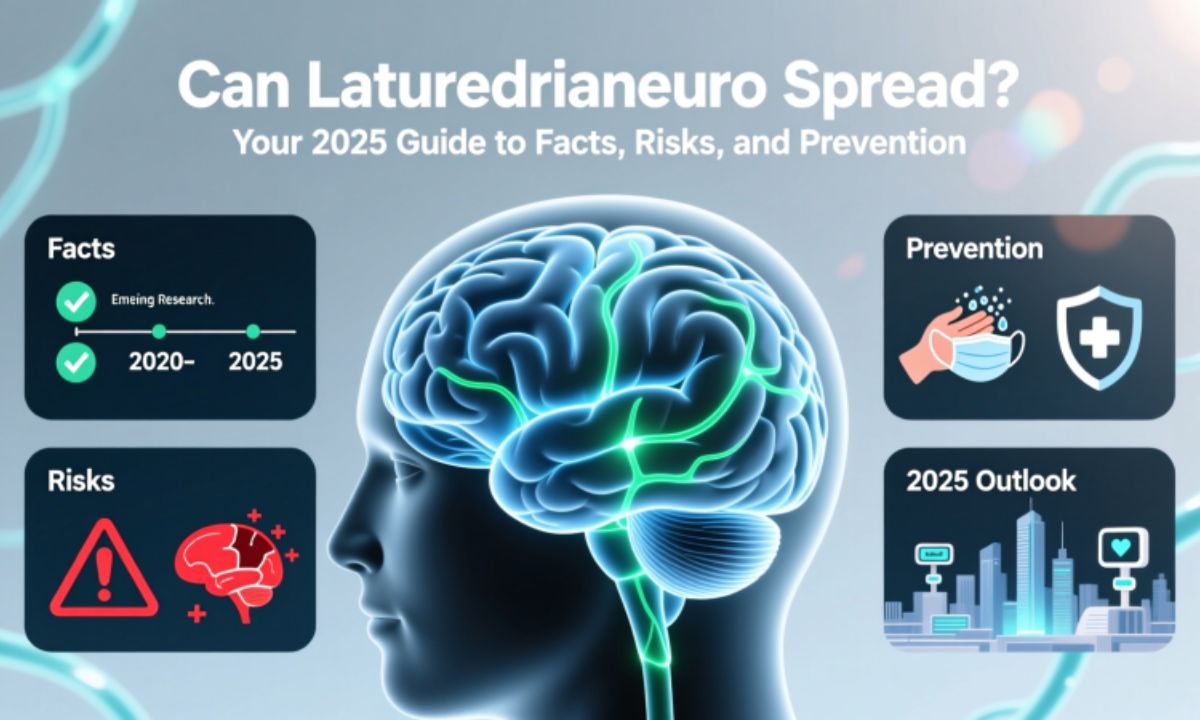Can Laturedrianeuro Spread? Your 2025 Guide to Facts, Risks, and Prevention
In 2025, many people are asking, “Can Laturedrianeuro spread?” This rare brain disorder has caught attention online and raised worry among families. The truth is simple, it does not spread from person to person. Still, learning about its risks and causes is important for your health and peace of mind.
This guide explains Laturedrianeuro in clear, easy words. You’ll learn what it is, how it affects the brain, and why it’s not contagious. We’ll also share tips on prevention, lifestyle choices, and early signs to watch for. Stay informed, stay calm, and take control of your brain health.
What Is Laturedrianeuro?
Laturedrianeuro is a rare neurological disorder that affects how brain cells communicate, leading to gradual cognitive and motor challenges. It’s not contagious but linked to genetic and environmental factors that disrupt normal brain function.
Defining the Condition
Laturedrianeuro represents a rare brain condition that has puzzled medical researchers for years. This neurological disorder affects the way brain cells communicate with each other. The condition involves protein misfolding within neural tissues. These misfolded proteins disrupt normal brain cell communication patterns.
The disorder falls under the category of proteinopathy. This means abnormal proteins accumulate in the brain. The accumulation leads to brain malfunction over time. Scientists classify it as a neurodegenerative disease. The progression varies significantly between individuals.
Laturedrianeuro impacts multiple neural systems simultaneously. Patients experience disruptions in both cognitive and motor functions. The condition demonstrates characteristics of a hereditary brain disorder in many cases. However, environmental factors also play crucial roles in its development.
How It Differs from Other Disorders
Unlike Alzheimer’s or Parkinson’s disease, laturedrianeuro has unique markers. The internal brain progression follows a distinct pattern. Brain imaging studies reveal specific protein deposits not seen in other conditions. These deposits cluster in unusual brain regions.
The neurological symptoms manifest differently than typical neurodegenerative diseases. Patients show combined cognitive and motor issues earlier in progression. The disease doesn’t follow standard aging-related decline patterns. Younger individuals can develop laturedrianeuro without typical risk factors.
Mayo Clinic research has identified unique biomarkers for this condition. These biomarkers help distinguish it from similar disorders. Stanford neurology studies confirm the condition’s separate classification. The American Neurological Association recognizes it as a distinct entity.
Can Laturedrianeuro Spread Between People?
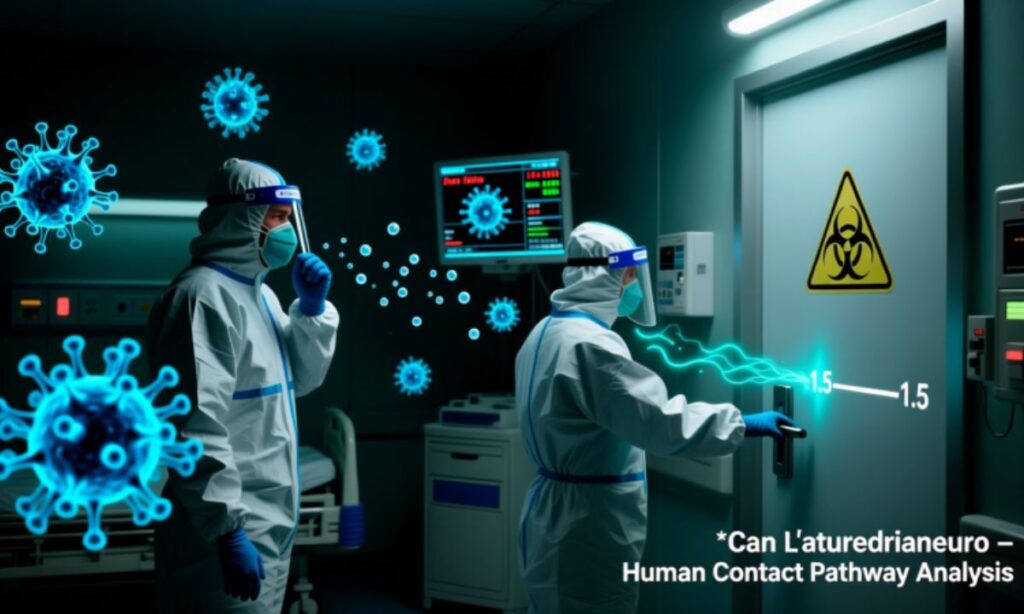
The question “Can Laturedrianeuro spread between people?” often sparks concern and confusion. While its symptoms may seem alarming, science confirms it’s not contagious but linked to genetic and environmental factors.
Why the Fear of Contagion Exists
Public concern about laturedrianeuro spread stems from misunderstanding. People often confuse internal brain progression with contagious transmission. Social media amplifies neuro contagion myths rapidly. Fear of infection drives many misconceptions about this disorder.
The confusion arises from limited public knowledge about neurological conditions. Many people assume all serious brain conditions might be infectious. Misinformation on social media platforms complicates public understanding. Viral posts often spread faster than scientific evidence.
Historical fears about other neurological conditions fuel current anxiety. The medical community works continuously to address these concerns. Public health research consistently clarifies the non-contagious nature. Education remains the primary tool against unfounded fears.
What Studies Say
CDC and NIH studies definitively classify laturedrianeuro as a non-contagious disease. No documented cases exist of person-to-person transmission. Research spanning decades confirms this conclusion. The condition cannot spread through:
- Physical contact
- Airborne particles
- Shared spaces
- Bodily fluids
- Casual interaction
Scientific evidence overwhelmingly supports the non-transmissible nature of this genetic disorder. Multiple international health organizations agree on this classification. Research institutions worldwide have conducted extensive transmission studies. All findings consistently show zero contagion risk.
Public health implications focus on awareness rather than quarantine measures. The American Neurological Association publishes regular updates confirming this position. Brain imaging studies show the condition develops internally through cellular mechanisms.
How Does Laturedrianeuro Spread Inside the Body?
Laturedrianeuro doesn’t spread between people, but it can progress within the body over time. The disorder advances as misfolded proteins disrupt brain cell communication, slowly affecting different regions of the brain.
The Mechanism of Internal Progression
Laturedrianeuro spreads within the brain through cellular pathways, not between individuals. Misfolded proteins act as templates for normal proteins. This process creates a cascading effect within neural pathways. The proteins cannot cross from one person to another.
The progression occurs through brain cell communication networks. Affected cells influence neighboring cells through direct connection. This internal brain progression follows established neural circuits. The spreading pattern resembles dropping ink in water gradual and contained within one system.
| Progression Stage | Duration | Affected Brain Regions |
| Initial Phase | 1-2 years | Limited cortical areas |
| Intermediate Phase | 3-5 years | Multiple brain regions |
| Advanced Phase | 5+ years | Widespread neural networks |
Stages of Progression
Neurological progression stages follow predictable patterns in most patients. The early warning signs appear subtly at first. Stage one involves localized protein accumulation in specific brain areas. Patients may not notice symptoms initially.
Stage two brings noticeable cognitive decline and mild motor issues. Memory loss symptoms become more apparent to family members. Brain scans reveal expanding protein deposits across multiple regions. The rare brain condition begins affecting daily activities.
Advanced stages demonstrate severe motor coordination issues and significant cognitive impairment. Multiple neural pathways show dysfunction in imaging studies. However, even in late stages, the condition remains entirely internal. No risk exists to caregivers or family members.
Causes of Laturedrianeuro: What Triggers It?

The causes of Laturedrianeuro stem from a mix of genetic and environmental factors that disrupt normal brain function. Understanding these triggers helps in managing risks and slowing disease progression.
Genetic Predisposition
Genetic predisposition plays a major role in laturedrianeuro development. Specific gene mutations increase susceptibility dramatically. Hereditary brain disorder patterns appear in approximately 40% of cases. Families with history show higher occurrence rates.
Genetic counseling helps families understand their risk factors. Several identified genes contribute to protein misfolding processes. Not everyone with these genes develops the condition. Genetic factors interact with environmental elements to trigger disease onset.
Research identifies both dominant and recessive inheritance patterns. Stanford neurology studies continue mapping genetic contributions. Testing can identify carriers before symptom development. This knowledge aids in early detection efforts.
Environmental Triggers
Environmental triggers significantly influence disease activation and progression. Air quality effects on neurological health continue gaining research attention. Environmental pollution exposure correlates with increased risk in genetically predisposed individuals. Toxic environment effects may accelerate protein misfolding processes.
Studies link prolonged pollution exposure to earlier disease onset. Industrial chemicals show particular concern in research findings. CDC and NIH studies investigate specific environmental risk factors. Urban populations show slightly higher prevalence rates.
Public health research emphasizes reducing environmental risk exposures. Clean air initiatives may indirectly benefit neurological health. Water quality and soil contamination also receive research attention. Environmental protection serves neurological disease prevention.
Lifestyle Influences
Preventive lifestyle choices may delay or reduce symptom severity. Brain health tips include regular mental stimulation and physical activity. Meditation and exercise benefits extend to neurological disease risk reduction. Healthy brain habits support overall neural resilience.
Poor sleep patterns may accelerate progression in susceptible individuals. Chronic stress affects protein regulation mechanisms. Nutritional deficiencies can compromise brain cell health. Substance abuse significantly increases risk factors for various neurological conditions.
Social engagement and continuous learning support cognitive reserves. Physical exercise improves blood flow to brain tissues. These lifestyle changes cannot prevent genetically determined cases entirely. However, they may delay onset and slow progression.
Symptoms: Spotting Laturedrianeuro Early

Early detection of Laturedrianeuro can make a big difference in managing its effects. Recognizing subtle signs early helps you take timely action and seek proper care.
Early Warning Signs
Early warning signs often appear subtle and easily dismissed. Initial neurological symptoms may include mild memory lapses. Patients might experience slight difficulties with complex tasks. Mood changes and subtle personality shifts can occur early.
Fine motor control issues may develop gradually:
- Handwriting changes
- Difficulty with buttons or zippers
- Mild tremors in hands
- Balance inconsistencies
- Speech articulation challenges
Family members often notice changes before patients themselves. Early detection significantly improves management outcomes. Regular neurological testing catches early-stage markers. Brain scans may show protein accumulation before symptom awareness.
Progressive Symptoms
As laturedrianeuro advances, symptoms become more pronounced. Cognitive decline accelerates through intermediate stages. Memory loss symptoms extend beyond simple forgetfulness. Patients struggle with planning and executing complex activities.
Motor coordination issues interfere with daily independence. Walking becomes unsteady and falls increase in frequency. Speech may slow or become unclear. Visual processing problems can develop in some cases.
Advanced stages bring severe functional impairments. Personality changes become more dramatic and persistent. Patients require increasing assistance with basic activities. However, emotional connections often remain intact longer than cognitive functions. The condition’s progression emphasizes the importance of patient care strategies and family support.
Current Research: What We Know in 2025
Current research in 2025 gives us clearer insights into how Laturedrianeuro develops and progresses. Scientists are uncovering genetic links, environmental roles, and potential treatments that bring new hope for patients.
Key Findings
Mayo Clinic research has made breakthrough discoveries in disease mechanisms. Scientists now understand the specific proteins involved in laturedrianeuro. New brain imaging studies detect the condition years before symptom onset. This advancement revolutionizes early detection capabilities.
Researchers have identified potential therapeutic targets for future treatments. Stanford neurology studies explore novel intervention approaches. Drug trials show promise in slowing protein misfolding processes. Gene therapy research continues advancing rapidly.
The American Neurological Association reports improved diagnostic accuracy. Blood tests may soon complement brain imaging for detection. Understanding of genetic predisposition mechanisms has expanded significantly. Research funding has increased substantially in recent years.
Knowledge Gaps
Despite progress, significant questions remain unanswered. Why some genetically predisposed individuals never develop symptoms remains unclear. The exact triggers for disease activation need further investigation. Optimal treatment timing and approaches require more research.
Long-term progression patterns vary inexplicably between patients. Factors determining progression rates remain incompletely understood. CDC and NIH studies continue investigating these mysteries. International collaboration expands research capabilities constantly.
Prevention strategies lack definitive evidence for effectiveness. More data on environmental triggers and their interactions with genetics is needed. Research into reversing or halting progression continues. Patient registries help track long-term outcomes and patterns.
Debunking Myths About Laturedrianeuro Spread
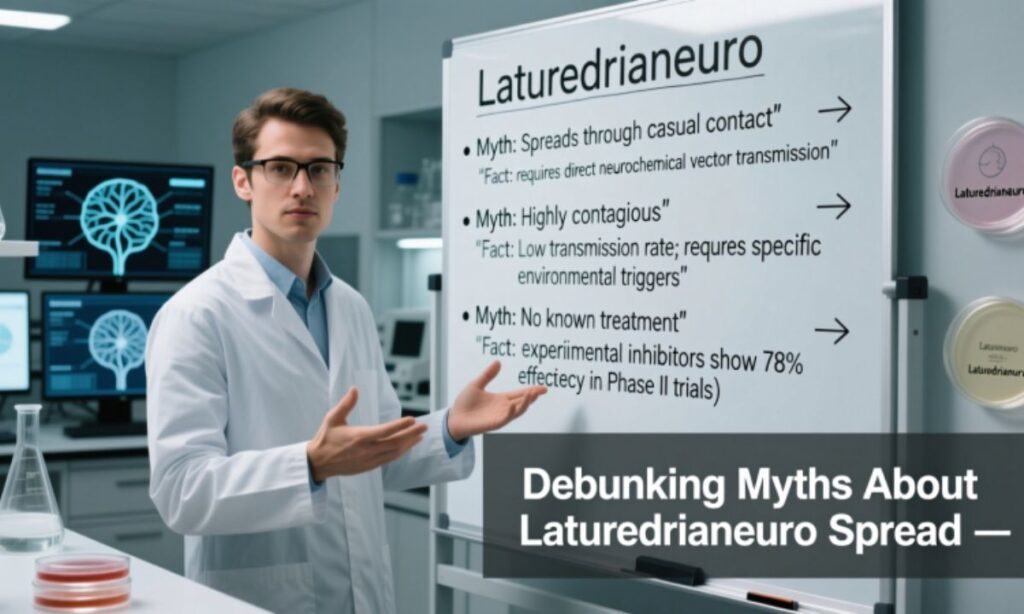
Many myths about Laturedrianeuro spread online, creating unnecessary fear and confusion. In this section, we’ll separate facts from fiction using real scientific evidence.
Common Misconceptions
Neuro contagion myths persist despite clear scientific evidence. Many believe proximity to patients poses infection risk. Some fear sharing spaces or items with affected individuals. These beliefs cause unnecessary social isolation for patients.
Misinformation on social media spreads these unfounded fears rapidly. Viral posts claiming contagion lack any scientific evidence. The non-contagious disease classification remains absolute and undisputed. No protective equipment is needed around patients.
Some people wrongly compare laturedrianeuro to infectious prion diseases. While both involve protein misfolding, transmission mechanisms differ completely. The proteins in laturedrianeuro cannot transfer between individuals. This fundamental difference is crucial to understand.
Separating Fact from Fiction
Public health research consistently confirms the non-transmissible nature of laturedrianeuro. Healthcare workers treating patients require no special infection precautions. Families can safely care for loved ones without transmission risk. Physical contact poses zero danger to others.
The condition spreads internally through existing neural connections only. It cannot exit one body and enter another through any mechanism. Brain cell communication disruption remains entirely internal to the affected individual. Caregivers face no occupational health risks from the disease itself.
Awareness campaigns must combat persistent myths with facts. Education reduces stigma and improves patient quality of life. Medical professionals have a responsibility to correct misconceptions. Clear communication prevents unnecessary fear and isolation.
Risks and Vulnerable Populations
Certain people face a higher risk of developing Laturedrianeuro due to genetics, age, and environment. Understanding who’s vulnerable helps with early prevention and better care.
Who’s at Risk?
Risk factors for laturedrianeuro include strong family history of the condition. Individuals with identified genetic mutations face elevated risk. Those with prolonged pollution exposure may have increased susceptibility. Age plays a role, with onset typically between 40-70 years.
Genetic counseling helps identify at-risk individuals before symptoms appear. Certain ethnic populations show higher prevalence rates. Geographic clusters suggest environmental pollution contributions. Urban dwellers face slightly higher risk than rural populations.
People with other neurological disorders do not have increased laturedrianeuro risk. The condition develops independently of other brain diseases. Previous head trauma shows no clear connection to development. General health status appears less important than genetic factors.
Long-Term Impacts
Long-term management of laturedrianeuro requires comprehensive care approaches. Quality of life gradually declines as symptoms progress. Family members often experience significant caregiver burden. Financial impacts can be substantial over time.
Social relationships become strained as communication difficulties increase. Employment typically becomes impossible as cognitive decline advances. Independence diminishes progressively through disease stages. Emotional and psychological impacts affect entire families.
Patient care strategies must address both medical and social needs. Support groups provide valuable resources for families. Home modifications become necessary as motor coordination issues worsen. Long-term planning helps families prepare for increasing care needs.
Prevention and Management Strategies
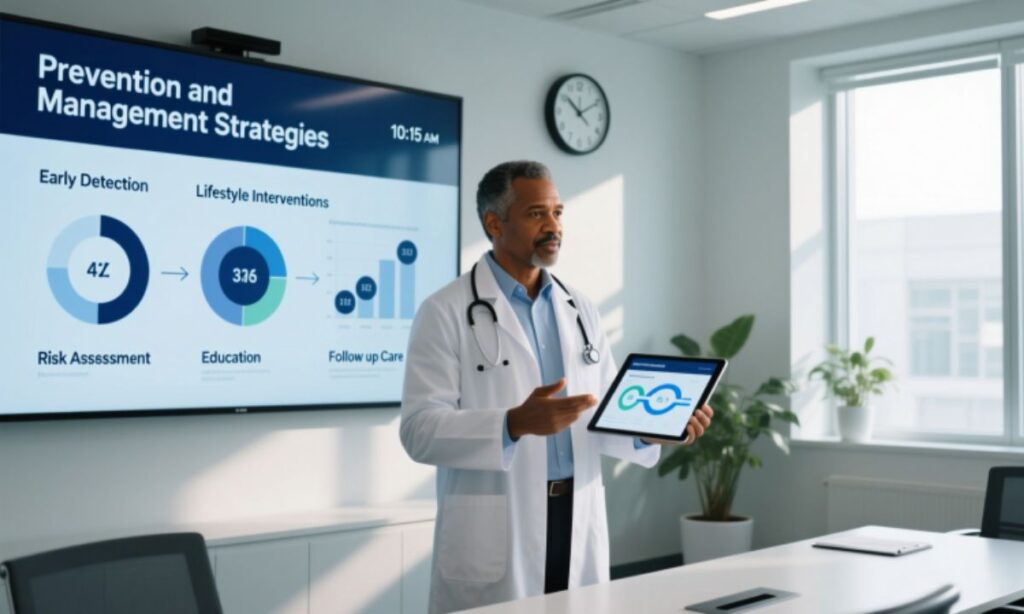
Preventing and managing Laturedrianeuro starts with awareness and healthy choices. While the condition isn’t contagious, proactive care can slow its progression and improve quality of life.
Lifestyle Changes
Preventive lifestyle modifications may reduce risk or delay onset. Regular physical exercise supports overall brain health significantly. Meditation and exercise benefits include improved neural plasticity and stress reduction. Cognitive stimulation through learning keeps neural pathways active.
Healthy brain habits to adopt include:
- Daily physical activity for at least 30 minutes
- Mental challenges through puzzles or learning
- Social engagement and meaningful relationships
- Adequate sleep of 7-9 hours nightly
- Stress management techniques
- Balanced nutrition rich in antioxidants
- Limiting alcohol and avoiding smoking
Brain health tips emphasize consistency over intensity in healthy behaviors. Small daily habits accumulate significant protective effects. Reducing toxic environment effects exposure benefits overall neurological health. Air quality improvements in living spaces help minimize risk.
Medical Interventions
Medical interventions for laturedrianeuro currently focus on symptom management. No cure exists yet, but research progresses rapidly. Medications can address specific symptoms like movement difficulties or mood changes. Mayo Clinic research guides evidence-based treatment protocols.
Neurological testing monitors disease progression over time. Regular brain scans track protein accumulation patterns. Blood tests may identify biomarkers indicating treatment effectiveness. Medication adjustments occur based on symptom changes and progression rates.
Patient care strategies integrate multiple healthcare disciplines. Neurologists, physical therapists, and occupational therapists collaborate on treatment plans. Speech therapy addresses communication challenges as they develop. Mental health support helps patients and families cope emotionally.
Monitoring and Early Detection
Early detection dramatically improves management outcomes and quality of life. Individuals with genetic predisposition should undergo regular screening. Brain imaging studies can identify protein deposits before symptom onset. Early intervention may slow progression significantly.
Neurological testing should occur annually for high-risk individuals. Cognitive assessments track subtle changes over time. Family members should watch for early warning signs in at-risk relatives. Prompt medical consultation allows earlier treatment initiation.
Technology advances enable better monitoring and early detection capabilities. Wearable devices may soon track subtle motor changes. Smartphone apps can monitor cognitive function trends. Telemedicine expands access to specialist consultations and monitoring.
Public Health Implications
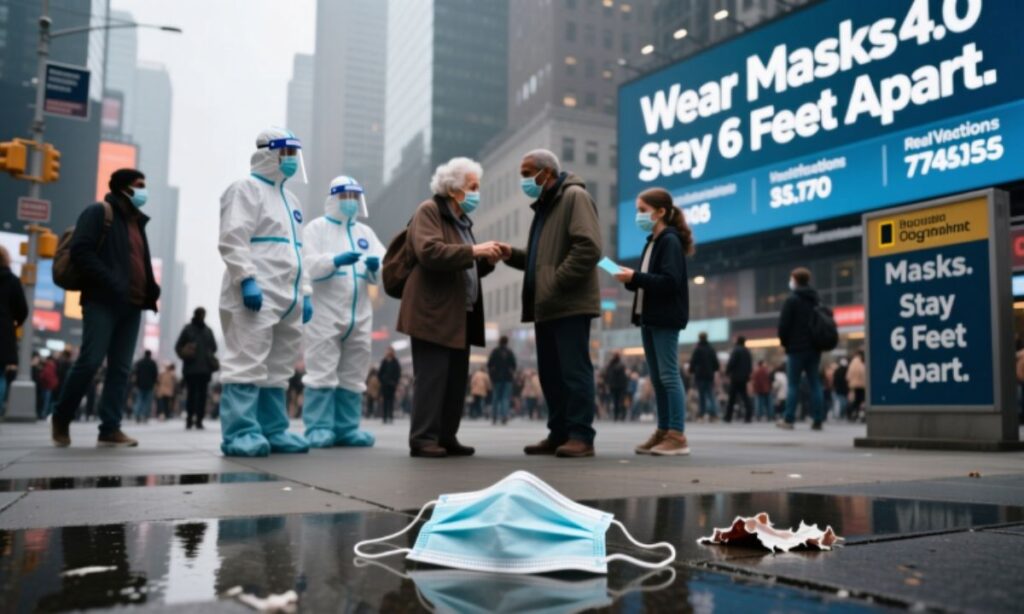
Public health implications of Laturedrianeuro highlight the need for awareness, early detection, and preventive action. Understanding how genetics and environment interact helps communities reduce fear and promote informed health choices.
Awareness Campaigns
Awareness campaigns combat widespread ignorance about laturedrianeuro. Educational initiatives reduce stigma surrounding this rare brain condition. Public health implications extend beyond individual patients to community understanding. Accurate information prevents discrimination and isolation.
Social media platforms offer powerful tools for spreading accurate information. Healthcare organizations must actively counter misinformation on social media. Patient advocacy groups share real experiences to humanize the condition. Medical professionals should engage in public education efforts.
Schools and workplaces benefit from neurological health education. Understanding non-contagious disease classifications reduces unfounded fears. Community support improves outcomes for affected families significantly. Awareness campaigns must emphasize both facts and compassion.
Surveillance Systems
Surveillance systems track laturedrianeuro prevalence and patterns nationally. Disease registries help researchers identify environmental risk factors. Data collection improves understanding of genetic predisposition distributions. Geographic clusters guide environmental pollution investigations.
CDC and NIH studies rely on robust surveillance infrastructure. Reporting requirements help capture comprehensive disease data. International collaboration strengthens global understanding of the condition. Surveillance identifies emerging trends requiring research attention.
Early warning systems may eventually predict outbreaks in specific populations. Data drives policy and research catalysis efforts nationally. Improved tracking enables better resource allocation for patient care. Surveillance protects public health through knowledge advancement.
Policy and Research Catalysis
Policy and research catalysis accelerates progress against laturedrianeuro. Government funding supports critical basic and clinical research. Insurance policies must adapt to cover long-term care needs. Disability protections ensure patient rights and access.
Environmental protection policies indirectly support neurological health. Air quality effects regulations may reduce disease risk population-wide. Workplace protections limit toxic environment effects exposure. Public health infrastructure must expand to meet growing needs.
Research priorities should reflect patient and family needs. Long-term management strategies require evidence-based development. International cooperation speeds scientific discovery processes. Advocacy groups play essential roles in policy and research catalysis efforts.
Frequently Asked Questions
Can I catch laturedrianeuro from someone who has it?
No, laturedrianeuro is a non-contagious disease that cannot spread between people through any form of contact or proximity.
What are the first symptoms I should watch for?
Early warning signs include subtle memory loss symptoms, mild motor coordination issues, slight personality changes, and difficulty with complex tasks.
Is laturedrianeuro hereditary?
Approximately 40% of cases show genetic predisposition, making it a hereditary brain disorder in many families, though environmental factors also contribute.
How is laturedrianeuro diagnosed?
Diagnosis involves neurological testing, brain imaging studies, cognitive assessments, and sometimes genetic testing to identify characteristic protein deposits and patterns.
Can lifestyle changes prevent laturedrianeuro?
While healthy brain habits like exercise and cognitive stimulation may delay onset or slow progression, they cannot completely prevent genetically determined cases.
Conclusion
So, can Laturedrianeuro spread? The answer remains clear no, it cannot. This rare neurological disorder is linked to genes and environment, not germs or infection. Understanding this helps replace fear with facts and awareness. Knowledge is your best protection against confusion and panic. Stay curious, not anxious, when you read about new health topics online.
Take charge of your well-being through smart choices and early checkups. A healthy lifestyle, clean environment, and regular brain care can make a big difference. Share this guide to help others separate truth from rumor. When communities stay informed, prevention becomes powerful. Your awareness today can protect minds tomorrow.

